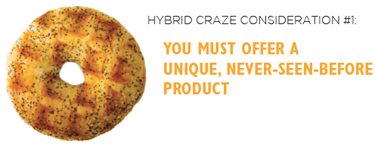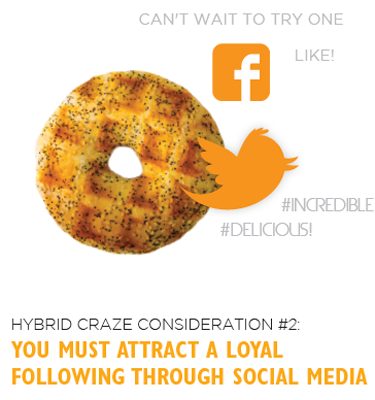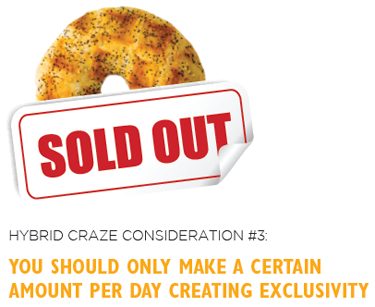
Every morning in New York City around 6:00a.m., a two-hour line forms outside Dominique Ansel’s Bakery with eager tourists and residents waiting to get their hands on the croissant-doughnut mashup that has exploded in popularity since May. The Cronut™ has become the most virally talked-about dessert item in history, and as a self-admitted sucker for fads – particularly one that is hard to get your hands on – you better believe if I were living in NYC, I’d be standing in that line.
And so I pose the question to myself and all of you: are we actually interested in tasting this decadent indulgence or are we more interested in the ability to share our one-of-a-kind experience via social media to all our friends and family? Matthew Stevens, editor of Dessert Professional, shares the three reasons he believes the Cronut™ has exceeded expectations, “First reason – novelty. People love new, yet familiar, treats that feed our fad food palates. Secondly – social media. The medium that fosters flash-mobs can spawn food-mobs too. And finally – FOMO (fear of missing out). Combine FOMO and social media and you get daily two-hour, pre-dawn lines for a Cronut™.”
 Let’s look at the basic breakdown of this new breed of desserts, the dessert hybrid. A dessert hybrid is a new concept in the culinary world that brings together two or more decadent items into one dish. The trick to these crossbreeds is bringing out the best of both worlds; one cannot overpower the other, they must perfectly complement one another. Bea’s of Bloomsbury Bakery in London brought together a gooey, old-fashioned brownie and a buttery tart to create the “townie.” A hit across the pond, the fusion dessert perfectly balances the rich, chocolaty center with a crunchy tart shell. Bea Vo, owner, shared with TODAY.com that “… with the brownie tart, the best part is the sugar crust on the top, and the fudgy soft centre that really makes for a strong chocolate hit.”
Let’s look at the basic breakdown of this new breed of desserts, the dessert hybrid. A dessert hybrid is a new concept in the culinary world that brings together two or more decadent items into one dish. The trick to these crossbreeds is bringing out the best of both worlds; one cannot overpower the other, they must perfectly complement one another. Bea’s of Bloomsbury Bakery in London brought together a gooey, old-fashioned brownie and a buttery tart to create the “townie.” A hit across the pond, the fusion dessert perfectly balances the rich, chocolaty center with a crunchy tart shell. Bea Vo, owner, shared with TODAY.com that “… with the brownie tart, the best part is the sugar crust on the top, and the fudgy soft centre that really makes for a strong chocolate hit.”
Another lovechild of two well-known desserts, the “Crookie” was developed by Pastry Chef Olivier Jansen-Reynaud of Clafouti Patisserie & Café in Toronto. This mashup features a flaky croissant stuffed with crushed Oreo cookies and topped with a melted Oreo on top. Jansen-Reynaud shared with FoxNews. com that this mashup came from his kids’ passion for Oreos and the fact that he’s always been good with croissants. Other bakeries are trying out classic couples like the brownie and cookie, cake and pie, muffin and waffle, doughnut and pancake combinations and much more. Trendhunter.com offers up wacky and weird pairings to try including a chocolate chip cookie grilled cheese, sweet potato pie fries, and coffee and donuts milkshake. The advantage of dessert hybrids is that almost anything can be paired together for delicious results; it’s a matter of finding two things that bring out the best in one another. Whether the pairing is more traditional or more out-there is f or us to decide.
 To become the next big thing, you must develop something exclusive and hard-to-get. Basic laws of supply and demand say that when demand increases and supply remains unchanged, a shortage occurs leading to a higher equilibrium price and an increased interest in the item. With only 250 available per day, the Cronut™ is a perfect example of this, and many bakeries and restaurants are wondering how to imitate it. The mastermind behind the pastry, Chef Dominique Ansel, shared in an interview withFox News magazine that he’s not sure what it is about his fried, doughy goodness that people can’t get enough of. He shares “I think it’s about the iconic status of two great foods – the croissant and the doughnut.”
To become the next big thing, you must develop something exclusive and hard-to-get. Basic laws of supply and demand say that when demand increases and supply remains unchanged, a shortage occurs leading to a higher equilibrium price and an increased interest in the item. With only 250 available per day, the Cronut™ is a perfect example of this, and many bakeries and restaurants are wondering how to imitate it. The mastermind behind the pastry, Chef Dominique Ansel, shared in an interview withFox News magazine that he’s not sure what it is about his fried, doughy goodness that people can’t get enough of. He shares “I think it’s about the iconic status of two great foods – the croissant and the doughnut.”
On the other hand, Kathleen Purvis, food editor for The Charlotte Observer, shares, “I don’t think the issue on hybrids is the mashup of two things people love. It’s the scarcity. People don’t stand in line for almost three hours just to have something that tastes like a cross between a croissant and a doughnut. They’re standing in line for bragging rights and for the communal experience. They want to eat something that’s hard to get so they can share the story of the experience, but it also has to be something with certain notoriety. What’s the point of going to the trouble or expense if none of your friends have heard of the item in question?”
 The issue for bakeries and restaurants out there is: if the man behind the legendary Cronut™ isn’t even sure how this craze came about (seeFox News magazine’s article), how is the rest of the world going to be successful at it? Sure, the pastry is indulgent, delicious and a perfect balance of flavors, but who in their right mind would stand in a two-hour line for this, rather than getting something similar up the street? There are no clear-cut answers but a few takeaways from the hybrid craze to be considered when launching your own dessert mashup: 1) you must offer a unique, never-seen-before product; 2) you must attract a loyal following through social media; 3) you should only make a certain amount per day, creating exclusivity. The whole idea of: when you tell someone they can’t have something, they only want it more.
The issue for bakeries and restaurants out there is: if the man behind the legendary Cronut™ isn’t even sure how this craze came about (seeFox News magazine’s article), how is the rest of the world going to be successful at it? Sure, the pastry is indulgent, delicious and a perfect balance of flavors, but who in their right mind would stand in a two-hour line for this, rather than getting something similar up the street? There are no clear-cut answers but a few takeaways from the hybrid craze to be considered when launching your own dessert mashup: 1) you must offer a unique, never-seen-before product; 2) you must attract a loyal following through social media; 3) you should only make a certain amount per day, creating exclusivity. The whole idea of: when you tell someone they can’t have something, they only want it more.
How businesses respond to this trend will be a defining factor of the hybrid craze. The way to be successful at this is to come up with a brand new idea, spend the time researching and developing it, and then send it viral. Dessert hybrids are one way to create a craze, but perhaps the next big thing will be an entirely different concept. Whatever the case may be, it should be a new, yet familiar dessert that consumers can relate to. It’s also important to have a strategy behind the launch, including promoting it to local food bloggers and other media that will write about it, creating a buzz.
